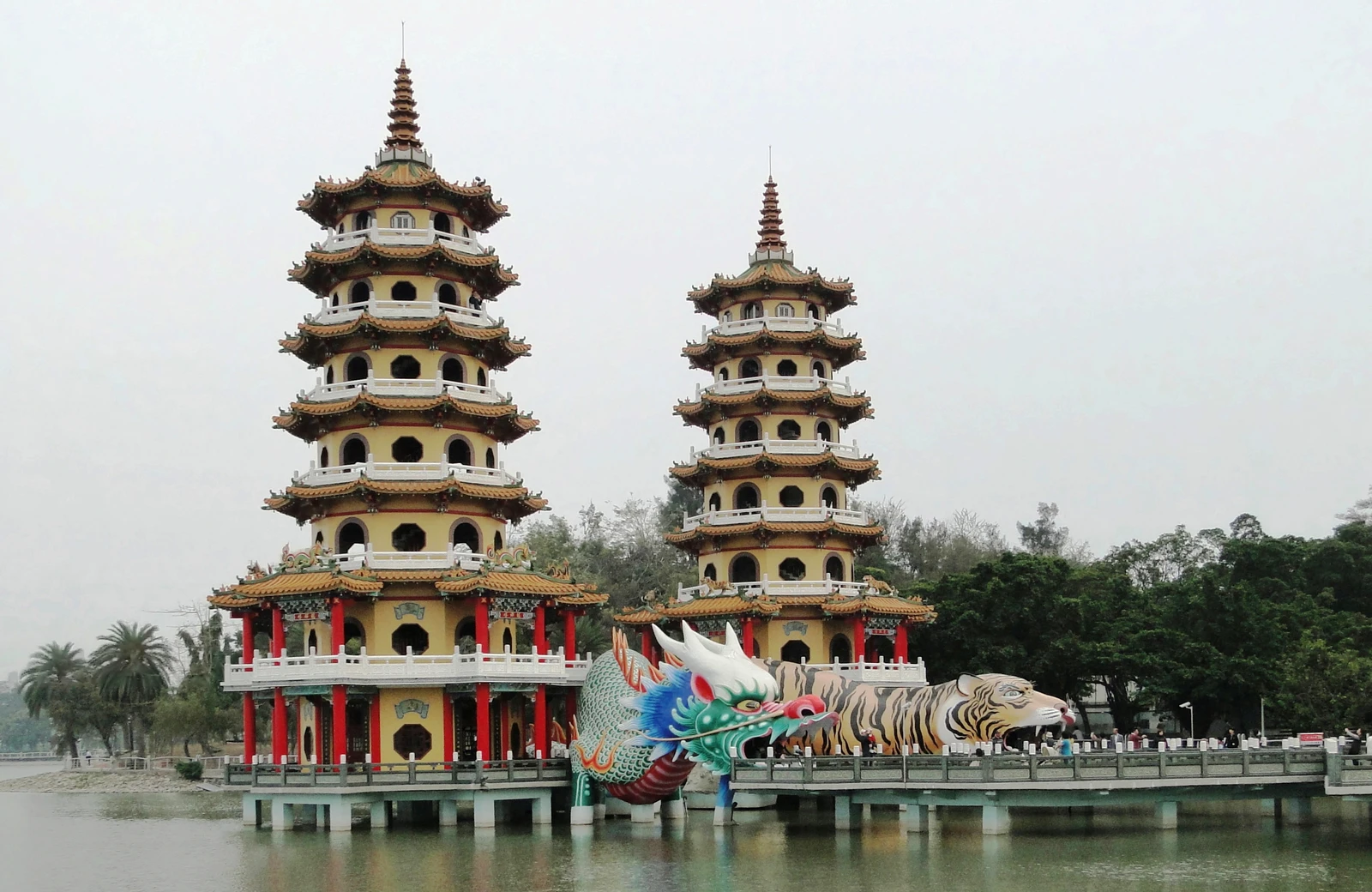The Dragon and Tiger Pagodas (龍虎塔, Lónghǔ Tǎ) are a unique and visually stunning temple complex located on Lotus Pond in the Zuoying District of Kaohsiung, Taiwan. Built in 1976, these vibrant, seven-story twin pagodas are renowned for their striking architecture, rich symbolism, and the unique cultural tradition of entering through the dragon’s mouth and exiting through the tiger’s mouth to turn bad luck into good fortune. They are one of Kaohsiung’s most recognizable and photographed landmarks.
![]()
Name: Dragon and Tiger Pagodas (龍虎塔, Lónghǔ Tǎ)
Address: Lianchihtan (Lotus Pond) Scenic Area, Zuoying District, Kaohsiung City, Taiwan.
How to get there:
The Dragon and Tiger Pagodas are a key attraction within the Lotus Pond Scenic Area and are easily accessible from central Kaohsiung:
- From Kaohsiung Main Station (Train/HSR):
- By MRT + Bus: Take the Kaohsiung MRT Red Line to Ecological District Station (R15). From there, transfer to local bus Red 35 and get off at Shengli Road, which is a very short walk (about 2 minutes) to the pagodas.
- By Train (TRA): Take a local train from Kaohsiung Main Station to Zuoying Station. From Zuoying Station, you can walk (about 20-30 minutes), take a taxi (short ride), or a local bus to Lotus Pond.
- By High-Speed Rail (HSR): If arriving in Kaohsiung by HSR, you will arrive at Zuoying HSR Station. From there, the pagodas are a short taxi ride, or you can connect to the local train/bus system towards Lotus Pond.
- By Taxi/Ride-Sharing Services: Taxis are readily available throughout Kaohsiung and can take you directly to the entrance area of Lotus Pond near the pagodas.
- Walking/Cycling: The Lotus Pond area is pedestrian-friendly, and you can rent bicycles to explore the various temples and attractions around the lake.
Landscape and Architecture:
The Dragon and Tiger Pagodas are vibrant examples of traditional Chinese temple architecture, beautifully integrated with the artificial Lotus Pond:
- Twin Seven-Story Pagodas: The complex consists of two identical seven-story pagodas, one representing a dragon and the other a tiger. Each tower is characterized by yellow walls, striking red pillars, and orange-tiled roofs, creating a vibrant and eye-catching appearance.
- Giant Dragon and Tiger Entrances: The most distinctive architectural feature are the large, colorful, and highly detailed sculptural representations of a dragon and a tiger, serving as the entrances to their respective pagodas. Visitors literally enter through the wide-open mouth of the dragon and exit through the mouth of the tiger.
- Zigzag Bridge: A picturesque zigzag bridge connects the pagodas to the shore of Lotus Pond. This design is also symbolic, believed to ward off evil spirits by confusing them, as evil spirits supposedly can only travel in straight lines.
- Elaborate Interior Murals: The interior walls of both the dragon and tiger structures, as well as the pagodas, are adorned with vivid and intricate paintings and relief sculptures. These depict scenes from Chinese folklore, Buddhist parables (like the ten courts of hell), Taoist cosmology (Jade Emperor’s palaces, the twelve Magi), and Confucian tales (the twenty-four filial exemplars), providing moral lessons and cultural insights.
- Double Spiral Staircases: Inside each pagoda, visitors can ascend the seven stories via double spiral staircases (one for ascending, one for descending), leading to observation points on each level.
- Lotus Pond Setting: The pagodas are situated directly on the artificial Lotus Pond, reflecting beautifully in the water, especially at sunset. The pond itself is a scenic area with other temples (like Spring and Autumn Pavilions, Chi Ming Palace) and attractions, making it a cohesive cultural landscape.
- Traditional Chinese Garden Elements: The surrounding area often features traditional Chinese garden elements like small bridges, pavilions, and landscaped pathways.
What makes it famous:
The Dragon and Tiger Pagodas are famous for:
- Symbolic “Enter Dragon, Exit Tiger”: The unique ritual of entering through the dragon’s mouth and exiting through the tiger’s mouth is its most famous aspect. This symbolic journey is believed to transform bad luck into good fortune and serves as a major draw for tourists seeking a cultural and spiritual experience.
- Vibrant Architecture: Their colorful, ornate, and distinctive traditional Chinese design, particularly the giant animal mouths, makes them instantly recognizable and highly photogenic.
- Integration of Chinese Mythology and Philosophy: The pagodas are steeped in Chinese folklore, Buddhist, Taoist, and Confucian teachings, with the dragon symbolizing power, auspiciousness, and water, and the tiger representing courage, righteousness, and warding off evil.
- Popular Kaohsiung Landmark: They are one of the most visited and iconic attractions in Kaohsiung, often featured in tourism promotions for the city.
- Reflections in Lotus Pond: The pagodas reflecting in the calm waters of Lotus Pond, especially at sunset, create a stunning visual, making it a favorite spot for photographers.
- Cultural Experience: Beyond just admiring the architecture, visitors engage with local beliefs, symbolism, and the broader context of Taiwanese religious practices.
Differences from some other wonders:
The Dragon and Tiger Pagodas stand out from other pagodas and religious sites in several distinctive ways:
- Interactive Symbolic Entrance/Exit: While many temples have symbolic gates, the literal act of entering through a dragon’s mouth and exiting through a tiger’s mouth to influence one’s fortune is a highly unique and engaging interactive element that sets these pagodas apart from virtually any other religious structure.
- Specific Animal Mythology as Primary Architectural Feature: The incorporation of massive, walk-through animal figures (dragon and tiger) as the main architectural entrances is incredibly specific and visually dramatic, distinguishing them from more conventional pagoda designs that might feature animal motifs but not on this scale or with this interactive function.
- Relatively Modern Construction with Traditional Aesthetics: Built in 1976, they are a relatively modern addition to Taiwan’s religious architecture, yet they are designed in a vibrant, traditional Chinese style, showing a continuation and re-interpretation of classical forms in the contemporary era, contrasting with truly ancient temples or modern minimalist designs.
- Emphasis on Fortune Transformation: The explicit and widely understood belief that visiting these pagodas can turn bad luck into good fortune gives them a distinct practical and ritualistic appeal beyond general spiritual merit or aesthetic appreciation found at many other temples.
- Part of a Cohesive Lake Temple Complex: While other single pagodas exist, the Dragon and Tiger Pagodas are a key part of a larger scenic lake area (Lotus Pond) with numerous other distinctive temples and pavilions (like the Spring and Autumn Pavilions, Confucius Temple), making it a concentrated hub of traditional Taiwanese religious and cultural architecture.
In essence, the Dragon and Tiger Pagodas are a vibrant, culturally rich, and incredibly unique wonder that offers an engaging blend of folklore, art, and auspicious symbolism, making them an unforgettable highlight of any visit to Kaohsiung.



























